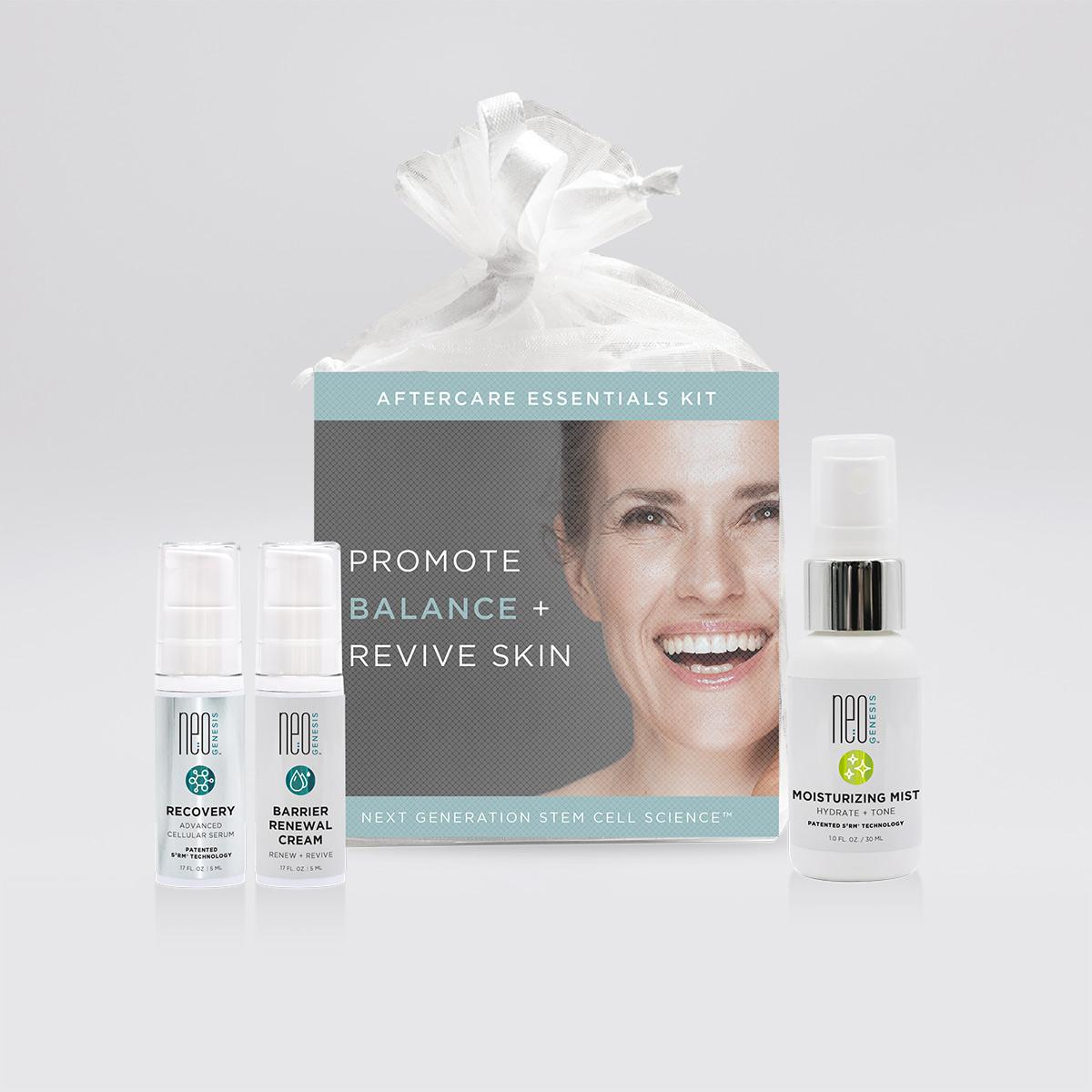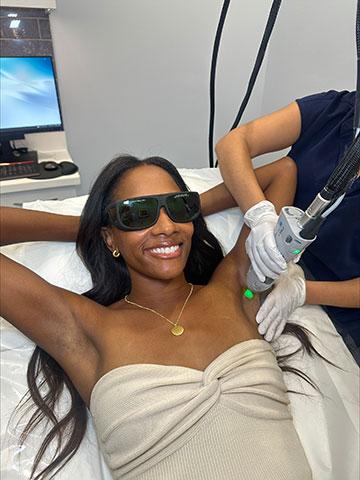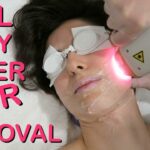In the quest for effortlessly smooth skin, laser hair removal has emerged as the shining beacon of hope for many. Promising to zap away unwanted fuzz with the precision of a high-tech wizard, it’s no wonder this treatment has skyrocketed in popularity. But beneath the dazzling allure of this modern marvel lies a cautionary tale—a reminder that even the brightest lights can cast the longest shadows. In “When Laser Hair Removal Goes Wrong,” we’re about to embark on a journey through the underbelly of this cosmetic wonderland. With a friendly hand to guide you, we’ll navigate the unexpected twists and turns that can transform a dream into a nightmare. So, buckle up, dear reader, as we pull back the curtain on the lesser-known realities of laser hair removal, shedding light on the hidden hazards you ought to know about.
Table of Contents
- Understanding the Risks: What Could Go Wrong
- Real-Life Stories: Lessons from Those Whove Been Burned
- Spotting Red Flags: How to Choose a Reputable Clinic
- Aftercare Essentials: Healing and Recovery Tips
- Considering Alternatives: Safe Options for Smooth Skin
- Q&A
- The Way Forward

Understanding the Risks: What Could Go Wrong
One of the most common risks associated with laser hair removal is skin irritation. This can range from mild redness and swelling to more severe reactions such as burns or blisters. These symptoms can occur immediately after treatment but usually resolve within several hours or days. To minimize the risk, it’s essential to ensure that your clinic uses the correct laser settings for your skin type and hair color. Here are a few **symptoms** to watch out for:
- Redness
- Swelling
- Blistering
- Temporary pigment changes
Another potential complication is **hyperpigmentation** or **hypopigmentation**. Hyperpigmentation refers to darkening of the skin, while hypopigmentation is the lightening of the skin. These changes can be temporary or permanent and are more likely to occur in individuals with darker skin tones. It’s crucial to follow aftercare instructions meticulously to avoid these pigmentary issues. Here’s how to improve your chances of successful healing:
- Avoid direct sunlight
- Use sunscreen regularly
- Avoid tanning beds
- Keep the treated area moisturized
Laser hair removal can also potentially exacerbate certain skin conditions. For instance, those with a history of keloid scars may find that the treatment triggers new keloid formations. People with skin conditions like eczema or psoriasis should consult their dermatologist before undergoing the procedure. The risks increase if pre-existing skin conditions are not disclosed to the technician. Here’s a quick reference:
| Condition | Potential Risk |
|---|---|
| Keloid Scars | New Scar Formation |
| Psoriasis | Flare-ups |
| Eczema | Increased Irritation |
Lastly, there is a risk of **eye damage** if protective eyewear is not used correctly during the procedure. Both the technician and the client should always wear goggles specifically designed for laser treatments. Accidentally looking directly at the laser can cause serious eye injuries, which may be permanent. Always make sure that your technician adheres to strict safety protocols to safeguard your eyes. Here’s a reminder of the essential safety measures:
- Wear protective eyewear
- Follow technician instructions closely
- Ensure equipment is up-to-date and well-maintained
- Verify the qualifications of your technician
Real-Life Stories: Lessons from Those Whove Been Burned
Meet Sarah: a vibrant 28-year-old who decided to invest in laser hair removal. Sarah was excited to finally say goodbye to the painful and time-consuming ritual of waxing. She opted for a popular clinic, trusting their high ratings and the promise of a painless experience. The first few sessions seemed fine, but things took a turn during her fourth appointment. Sarah noticed unusual redness and bumpiness, but the technician assured her it was normal and would subside soon.
The days that followed were anything but normal. Sarah experienced intense burning sensations and noticed dark patches appearing on her skin. Her confidence plummeted as she observed these alarming changes. Desperate for answers, she turned to the clinic, which offered little more than generic advice. Feeling lost, she sought help from a dermatologist who diagnosed her with second-degree burns and hyperpigmentation. The dream of smooth, hair-free skin had quickly morphed into a distressing ordeal.
| Warning Signs | What to Do |
|---|---|
| Persistent Redness | Consult a Dermatologist |
| Burning Sensation | Stop Treatment Immediately |
| Dark/Light Patches | Seek Professional Help |
Lessons Learned: Sarah’s experience underscores the importance of conducting thorough research before undergoing any cosmetic procedure. Here are some key takeaways to consider before booking your own appointments:
- **Certification** – Always verify the qualifications of the technician.
- **Patch Tests** – Insist on a patch test to identify potential skin reactions beforehand.
- **Reviews** – Look for reviews outside the clinic’s website for unbiased feedback.
Taking these steps can help ensure that your journey to smooth skin is a safe and successful one.

Spotting Red Flags: How to Choose a Reputable Clinic
Choosing the right clinic for your laser hair removal journey is pivotal. The first major indicator of a reputable clinic is transparency. High-quality clinics will readily provide **detailed explanations of the procedures**, expected outcomes, and potential risks involved. They will also have a clear and accessible pricing structure without hidden fees. Always ask to see **before and after photos** of previous clients; a credible clinic will proudly showcase their success stories.
Another significant red flag is the presence of inexperienced or non-certified technicians. It’s crucial to ensure that the person performing the laser hair removal is a **licensed professional with specialized training**. Reputable clinics often have their technicians’ credentials displayed or easily available for review. In addition, continued education and certifications show a commitment to staying current with the latest advancements and safety protocols in laser hair removal technology.
The type of equipment used is another critical factor. **Top clinics invest in the latest, FDA-approved laser systems** which offer the highest safety and efficacy. If a clinic uses outdated or poorly maintained equipment, it can lead to subpar results or even severe skin damage. During your consultation, don’t hesitate to ask about the specific laser technology being used and its suitability for your skin type and hair color.
Apart from these factors, pay attention to the overall ambiance of the clinic. Cleanliness, professional demeanor from staff, and a welcoming atmosphere are signs of a clinic that takes its services seriously. Reading **online reviews and testimonials** can also provide insights into previous clients’ experiences. Below is a summary table to help you quickly assess a clinic’s reputation:
| Criteria | Yes | No |
|---|---|---|
| Transparency and Detailed Explanations | ✔️ | ❌ |
| Certified and Experienced Technicians | ✔️ | ❌ |
| Latest, FDA-Approved Equipment | ✔️ | ❌ |
| Positive Online Reviews | ✔️ | ❌ |

Aftercare Essentials: Healing and Recovery Tips
Proper aftercare is crucial for ensuring a smooth recovery post-laser hair removal, especially if complications arise. Following a few essential steps can make the world of difference in healing effectively and minimizing discomfort. Here are some key tips:
- Stay Hydrated: Drinking plenty of water helps your skin repair itself and maintain elasticity. Aim for at least eight glasses a day.
- Avoid Direct Sunlight: Exposure to the sun can aggravate irritated skin. Wear loose, protective clothing and a wide-brimmed hat if you need to go outside.
- Cool Compresses: Applying cool, damp cloths to the affected areas can relieve inflammation and reduce redness. Do this for 10-15 minutes every few hours as needed.
Anticipate specific aftercare products that can significantly aid in your recovery. Utilizing these items can speed up the healing process and soothe irritated skin:
| Product | Benefit |
|---|---|
| Aloe Vera Gel | Soothes and cools the skin, reducing inflammation. |
| Hydrocortisone Cream | Reduces itching and irritation. |
| Fragrance-Free Moisturizer | Helps maintain skin hydration without adding irritation. |
Avoiding certain activities and substances following your treatment is also vital. Here’s a quick checklist of things to steer clear of:
- Hot Showers and Baths: Exposing treated areas to hot water can exacerbate irritation.
- Excessive Sweating: Strenuous exercise and saunas can increase the likelihood of infection.
- Harsh Skin Products: Skip products containing alcohol or exfoliants, which can irritate the skin further.
Lastly, be sure to reach out to your dermatologist or treatment provider if you experience any unusual symptoms like severe pain, blistering, or signs of infection. They can offer professional advice or medication if needed. It’s always better to be safe and check in with a healthcare provider when in doubt.
Considering Alternatives: Safe Options for Smooth Skin
When faced with the aftermath of a laser hair removal mishap, it’s natural to explore alternative methods for achieving smooth, hair-free skin. Let’s delve into some safe and effective options that can give you the results you desire without the risks associated with intensive procedures.
1. Traditional Shaving
Legitimate, time-tested, and straightforward—shaving remains a staple for many. Here are some tips for achieving the best shave:
- Use a sharp razor: A dull blade can lead to nicks and irritation.
- Hydrate the skin: Warm water and shaving gel/cream help soften the hair.
- Shave in the direction of hair growth: This reduces the chances of ingrown hairs and skin irritation.
Though not permanent, shaving provides immediate results and is easy on the wallet, making it a go-to option for many seeking smooth skin.
2. Sugaring and Waxing
These age-old techniques offer longer-lasting results compared to shaving. Both methods involve applying a sticky substance to the skin and then pulling the hair out from the root. Here’s a quick comparison:
| Method | Pros | Cons |
|---|---|---|
| Sugaring | Natural ingredients, less painful than waxing | Can be messy |
| Waxing | Accessible, effective for short hairs | More painful, risk of burns if not done correctly |
Whichever method you choose, ensure proper aftercare to keep your skin smooth and irritation-free.
3. Depilatory Creams
Depilatory creams offer a pain-free alternative that dissolves hair just below the skin surface. Known for their ease of use, here are some quick tips:
- Patch test first: Ensure you’re not allergic or sensitive to the cream.
- Follow instructions: Don’t leave the cream on for longer than recommended.
- Moisturize after use: Keeps your skin hydrated and smooth.
This method provides a quick and effortless way to keep your skin hair-free without the commitment.
4. Professional Threading
Popular for facial hair removal, particularly eyebrows, threading is highly precise and chemical-free. Here are some benefits:
- No chemicals: Ideal for sensitive skin types.
- Precision: Great for shaping eyebrows.
- Hygienic: Minimal contact with skin reduces the risk of infections.
While threading is primarily for smaller areas, its meticulous approach makes it a top pick for those seeking perfect brows and smooth skin.
Exploring these alternatives can save you from the potential pitfalls of laser hair removal gone awry, offering a mix of convenience, safety, and effectiveness.
Q&A
Q&A for “When Laser Hair Removal Goes Wrong: A Cautionary Tale”
Q1: So, tell me, what exactly went wrong with this laser hair removal story?
A1: Ah, the tale of woe! Imagine going for a smooth, hair-free summer and ending up with something that looks more like alien crop circles on your leg. In this story, our intrepid protagonist experienced burns, patchy hair removal, and some very uneven results. It was like a recipe for disaster got sprinkled with bad luck and stirred with a laser.
Q2: How can burns happen during a laser hair removal session?
A2: Great question! Burns can occur when the laser’s heat is too intense for the skin type, or if the technician mishandles the equipment. It’s a bit like cooking – if you crank up the heat too high, you can scorch the dish. In our friend’s case, the machine was set to “volcano” instead of “sunny day.”
Q3: Is there any way to prevent these mishaps before going under the laser?
A3: Oh, absolutely! Doing a little homework can save your skin, quite literally. Look for a clinic with certified and experienced technicians. Always check reviews and ask for a patch test. It’s like test-driving a car – you want to make sure it’s safe and smooth before committing to the ride.
Q4: How important is the consultation, really? Aren’t they all the same?
A4: Think of the consultation as a first date. It’s crucial! This is the time to discuss skin types, hair colors, medical history, and any concerns you might have. A good tech will tailor the treatment plan to you, just like a well-planned date night. Our story’s hero skipped this step, and let’s just say, they got ghosted by good results.
Q5: What should you do if things go pear-shaped during the procedure?
A5: First thing is to speak up. If you feel any unusual pain or discomfort, let the technician know immediately. It’s not the time for bravery. Post-procedure, if you notice any burns or severe irritation, see a dermatologist as quick as a bunny! Don’t rely on just ice packs and wishful thinking.
Q6: Can you still achieve good results after a bad laser experience?
A6: Absolutely, there’s hope! It might be a longer journey, but finding the right professional can set things back on track. Just like a bad haircut can eventually grow out and be corrected, so can mismanaged hair removal. With the right care, your skin and confidence can still shine.
Q7: Is laser hair removal still worth considering after hearing this tale?
A7: For sure! Laser hair removal can be life-changing for many – in a good way! It’s all about finding that reputable clinic with skilled professionals. Treat this story as a reminder to be cautious, not as a deterrent. Do your research, trust your gut, and you’ll likely find yourself on the brighter side of the laser.
Q8: Any final words of wisdom for someone considering laser hair removal?
A8: Always remember, smooth sailing requires smooth planning. Don’t rush into it because of a great deal or peer pressure. Take the time to educate yourself, choose wisely, and never hesitate to ask questions. Your skin deserves the best care, and a little precaution goes a long way towards ensuring you’ll be happily hair-free. Cheers to smooth adventures ahead!
The Way Forward
As we wrap up this cautionary tale of when laser hair removal goes wrong, remember that knowledge is your best ally in achieving smooth, hair-free skin. While the allure of silky-smooth legs or a flawless bikini line is tempting, it’s essential to tread carefully and make informed decisions.
Always do your homework, checking credentials and reviews of clinics and practitioners. Don’t hesitate to ask questions and demand clear answers — it’s your body, after all. And should you ever find yourself in the crosshairs of an unexpected laser misfire, take solace in knowing that there are avenues for healing and recovery.
Navigating the world of cosmetic procedures can feel like walking a tightrope, but with a little caution, you can safely balance your way to the aesthetic goals you dream of. Here’s to being beautifully wise and wisely beautiful. Stay curious, stay safe, and most importantly, stay confident in your skin. Until next time! 🌟






